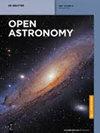基于半导体望远镜的高能质子探测器
IF 0.5
4区 物理与天体物理
Q4 ASTRONOMY & ASTROPHYSICS
引用次数: 0
摘要
摘要空间辐射粒子会对轨道卫星产生多种辐射效应,如单次事件效应、总电离剂量、位移损伤等。为了应对这些空间辐射效应,运行在中地球轨道(MEO)的北斗导航卫星M15/M16开发了首个高能质子和粒子辐射效应综合监测器,基于空间粒子辐射探测技术。该有效载荷实现了对MEO中高能质子环境、粒子辐射线性能量转移谱和总辐射剂量的联合观测。根据探测数据,可以对空间粒子辐射效应的特征和规律进行研究,从因果链上解决航天器在轨可靠性验证问题。在这篇文章中,我们介绍了高能质子探测器(能量范围3–300 MeV),包括技术指标、工作原理、仪器设计和地面校准。本文章由计算机程序翻译,如有差异,请以英文原文为准。
High-energy proton detector based on semiconductor telescope
Abstract Space radiation particles will cause a variety of radiation effects on orbiting satellites, such as single event effects, total ionizing dose, displacement damage, etc. In response to these space radiation effects, BeiDou Navigation satellites M15/M16 operating in medium earth orbit (MEO) developed the first integrated monitor for high-energy proton and particle radiation effects, based on space particle radiation detection technology. This payload realizes the joint observation of the high-energy proton environment, particle radiation linear energy transfer spectrum, and total radiation dose in the MEO. According to the detection data, research on the characteristics and laws of the space particle radiation effects can be carried out, and the problem of spacecraft reliability verification in orbit can be solved from the causal chain. In this article, we have introduced the high-energy proton detector (energy range 3–300 MeV), including technical indicators, working principles, instrument design, and ground calibration.
求助全文
通过发布文献求助,成功后即可免费获取论文全文。
去求助
来源期刊

Open Astronomy
Physics and Astronomy-Astronomy and Astrophysics
CiteScore
1.30
自引率
14.30%
发文量
37
审稿时长
16 weeks
期刊介绍:
The journal disseminates research in both observational and theoretical astronomy, astrophysics, solar physics, cosmology, galactic and extragalactic astronomy, high energy particles physics, planetary science, space science and astronomy-related astrobiology, presenting as well the surveys dedicated to astronomical history and education.
 求助内容:
求助内容: 应助结果提醒方式:
应助结果提醒方式:


